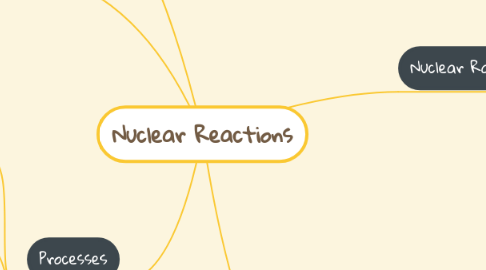
1. Radioactivity
1.1. nuclear reaction or radiation emitted by a radioactive isotope
1.2. this is measured using the Geiger counter -- filled with Argon that ionizes when in contact with radiation
1.2.1. disintegrations per second
1.2.2. Becquerel (Bq)
1.2.3. Curie (Ci)
2. Processes
2.1. Nuclear Fission
2.1.1. splitting apart of heavy nucleus into lighter nuclei and neutrons
2.1.2. used in nuclear power plants
2.2. Nuclear Fusion
2.2.1. joining together of two light nuclei to form a larger nucleus
2.2.2. happens in the sun
2.3. Radioactive Decay
2.3.1. the process by which an unstable radioactive nucleus emits radiation forming a nucleus of new composition
2.3.1.1. alpha decay
2.3.1.2. beta decay
2.3.1.3. positron emission
2.3.1.4. gamma emission
3. Radioactive Isotope
3.1. also called radioisotope
3.2. these are unstable and spontaneously emits energy to form a more stable nucleus
4. Nuclear Radiation
4.1. energy particles or rays that are given off from a radioactive element as it decays
4.1.1. alpha particle
4.1.1.1. high energy particle that contains two protons and two neutrons
4.1.2. beta particle
4.1.2.1. high-energy electron; formed when a neutron is converted to a proton and an electron
4.1.3. positron
4.1.3.1. called an antiparticle of a beta particle since their charges are different but their masses are the same
4.1.4. gamma rays
4.1.4.1. high-energy radiation released from a radioactive nucleus; no mass or charge
5. Half-life
5.1. time it takes for one half of a sample to decay
5.1.1. Carbon-14 = 5730 years
5.1.2. Iodine-131 = 8 days
5.1.3. Cobalt-60 = 5.3 years
5.1.4. Phosphorus-32 = 14.3 days
5.2. Uses
5.2.1. Archaeological dating
5.2.2. Geological dating
5.2.3. Cancer treatment
5.2.4. X-ray imaging

